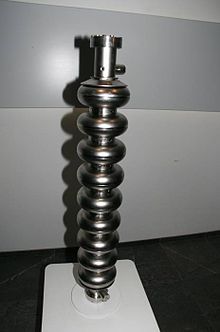TESLA (particle accelerator)

TESLA ( acronym for TeV-Energy Superconducting Linear Accelerator ; German " Superconducting linear accelerator for Tera - electron volt energies " with an allusion to the Tesla unit of measurement of magnetic flux density ) was the name of a project proposal from the year 2000 for a linear superconducting electron accelerator .
Originally, TESLA was to include two systems: a 33 km long linear accelerator for particle physics and an integrated 4 km long X-ray laser . Both sub-areas have been completely separated and will be continued as independent projects. In February 2003 the Federal Ministry of Education and Research (BMBF) made the fundamental decision to implement the X-ray laser as the European XFEL project in Hamburg. The idea of a 30 - 40 km long electron linear accelerator for particle physics is being promoted as the International Linear Collider (ILC).
The TESLA technology of superconducting high-frequency resonators made of niobium for electron accelerators is continuously being further developed in international cooperation. In the 315 m long free-electron laser FLASH at DESY in Hamburg, the cavities cooled to −271 ° C (see picture) are tested and used.